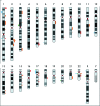Emerging patterns of cryptic chromosomal imbalance in patients with idiopathic mental retardation and multiple congenital anomalies: a new series of 140 patients and review of published reports
- PMID: 16490798
- PMCID: PMC2564583
- DOI: 10.1136/jmg.2005.039453
Emerging patterns of cryptic chromosomal imbalance in patients with idiopathic mental retardation and multiple congenital anomalies: a new series of 140 patients and review of published reports
Abstract
Background: Chromosomal abnormalities are a major cause of mental retardation and multiple congenital anomalies (MCA/MR). Screening for these chromosomal imbalances has mainly been done by standard karyotyping. Previous array CGH studies on selected patients with chromosomal phenotypes and normal karyotypes suggested an incidence of 10-15% of previously unnoticed de novo chromosomal imbalances.
Objective: To report array CGH screening of a series of 140 patients (the largest published so far) with idiopathic MCA/MR but normal karyotype.
Results: Submicroscopic chromosomal imbalances were detected in 28 of the 140 patients (20%) and included 18 deletions, seven duplications, and three unbalanced translocations. Seventeen of 24 imbalances were confirmed de novo and 19 were assumed to be causal. Excluding subtelomeric imbalances, our study identified 11 clinically relevant interstitial submicroscopic imbalances (8%). Taking this and previously reported studies into consideration, array CGH screening with a resolution of at least 1 Mb has been undertaken on 432 patients with MCA/MR. Most imbalances are non-recurrent and spread across the genome. In at least 8.8% of these patients (38 of 432) de novo intrachromosomal alterations have been identified.
Conclusions: Array CGH should be considered an essential aspect of the genetic analysis of patients with MCA/MR. In addition, in the present study three patients were mosaic for a structural chromosome rearrangement. One of these patients had monosomy 7 in as few as 8% of the cells, showing that array CGH allows detection of low grade mosaicisims.
Conflict of interest statement
Conflicts of interest: none declared
References
-
- Flint J, Wilkie A O, Buckle V J, Winter R M, Holland A J, McDermid H E. The detection of subtelomeric chromosomal rearrangements in idiopathic mental retardation. Nat Genet 19959132–140. - PubMed
-
- Knight S J, Horsley S W, Regan R, Lawrie N M, Maher E J, Cardy D L, Flint J, Kearney L. Development and clinical application of an innovative fluorescence in situ hybridization technique which detects submicroscopic rearrangements involving telomeres. Eur J Hum Genet 199751–8. - PubMed
-
- Koolen D A, Nillesen W M, Versteeg M H, Merkx G F, Knoers N V, Kets M, Vermeer S, van Ravenswaaij C M, de Kovel C G, Brunner H G, Smeets D, de Vries B B, Sistermans E A. Screening for subtelomeric rearrangements in 210 patients with unexplained mental retardation using multiplex ligation dependent probe amplification (MLPA). J Med Genet 200441892–899. - PMC - PubMed
-
- Solinas‐Toldo S, Lampel S, Stilgenbauer S, Nickolenko J, Benner A, Dohner H, Cremer T, Lichter P. Matrix‐based comparative genomic hybridization: biochips to screen for genomic imbalances. Genes Chromosomes Cancer 199720399–407. - PubMed
Publication types
MeSH terms
Grants and funding
LinkOut - more resources
Full Text Sources
Miscellaneous


